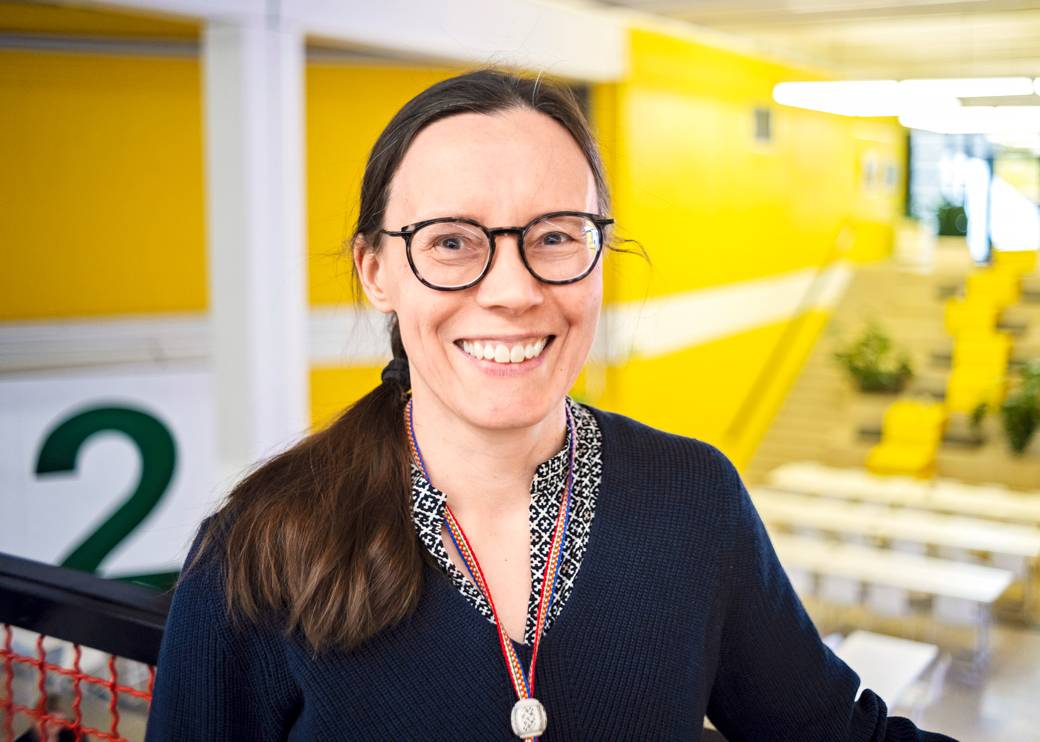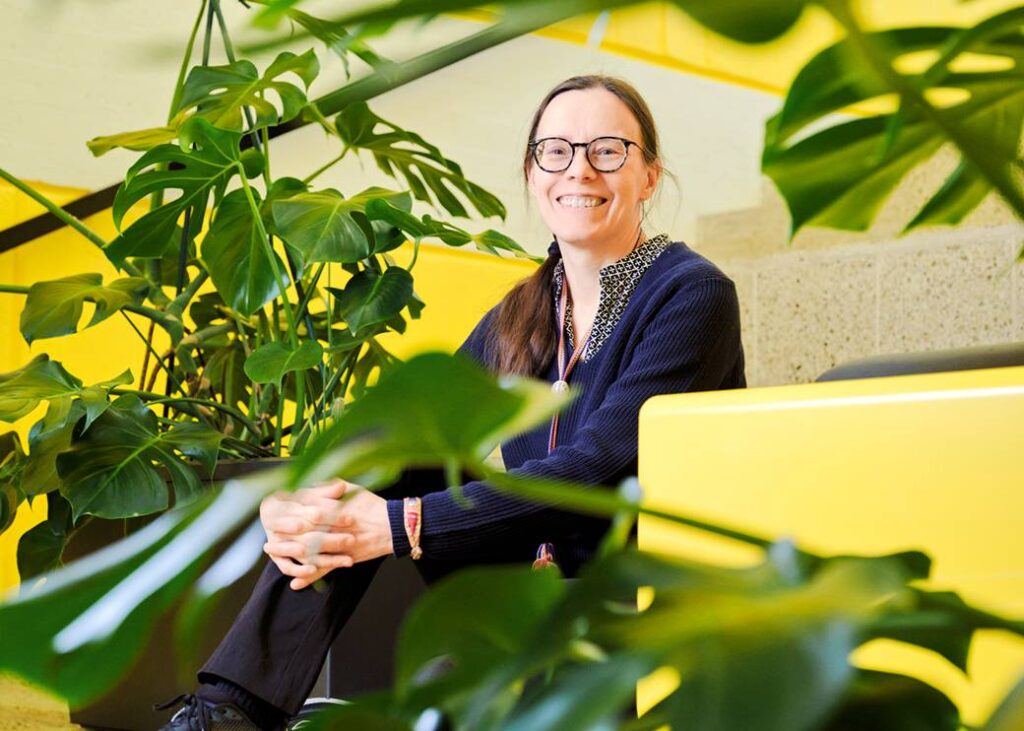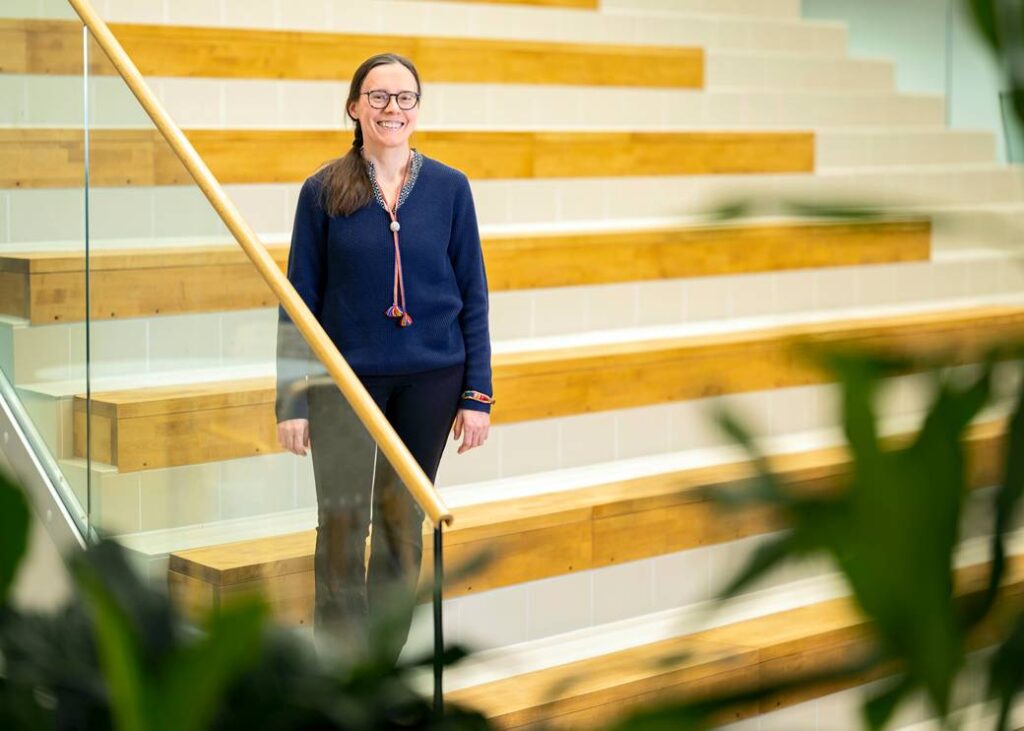
The Sámi people have a basic right to retain their language and culture
Studying indigenous peoples is important for ensuring history does not repeat itself, says Giellagas Institute Director Sigga-Marja Magga.
Text minna hiidensaari images juuso haarala translation marko saajanaho
“The fact the Sámi people have their own culture and social system comes as a surprise to many”, says Director of the Giellagas Institute and Docent of Sámi Handicrafts (Duodji) Sigga-Marja Magga.
“The majority population lacks basic knowledge. Discussion becomes difficult if understanding is outdated or skewed.”
The Giellagas Institute, which has operated as a separate unit of the University of Oulu’s Faculty of Humanities, focuses on correcting that lack of knowledge as one of their objectives. The Institute has a responsibility assigned by the Ministry of Education and Culture to organise and promote higher Sámi language and culture education and research in Finland. The core purpose of the Institute is to serve the Sámi community.
“As an indigenous people, the Sámi have a constitutional right to retain and preserve their language and culture.”

Many Giellagas Institute alumni are positioned as Sámi society builders in media, education, and the Sámi Parliament, to name a few examples. The rights of indigenous peoples to their land, language, and culture have been systematically trampled on in several countries. Finland is no exception.
“Information about the Sámi has also been misused to advance political agendas, for example. As such, it is important to be critical about what versions have appeared in history books, who is in charge of forming that information, and the motives behind using the information.”
The history of indigenous peoples is simultaneously part of the majority population’s history.
“The majority population has the right to know about the history of their country, such as what happened in the wars and the details of border arrangements in different eras.”
”The majority population has the right to know about the history of their country, such as what happened in the wars and the details of border arrangements in different eras.”
“Is it widely known what went on with the removal of Finland’s arm in World War II, or how those events affected the Skolt Sámi, for example? In history books, the situation may seem simpler than it was in reality.”
Research is an important way to ensure both the Sámi themselves and the majority population gain new knowledge and wider perspectives. Studying indigenous peoples is essential to prevent history from repeating itself.
Questions and listening
Research viewpoints also deserve a critical look. Sámi rights are also about the right to their own knowledge.
“Researchers must understand their majority position. We teach scientific responsibility to the students as early as the bachelor’s degree stage. A researcher must be able to consider their own research position, what the field is, and what the results of the research will be.”
Research fatigue is tremendous, especially when the researcher’s groundwork is inadequate. Occasionally, Sámi people may be forced to teach researchers about Sámi culture.
“Academia does not guarantee that the importance of sensitivity is understood when researching the Sámi. For example, universities in other countries may not see the power imbalance between the majority population and indigenous peoples. Matters related to Sámi spirituality, for instance, are often not examined from a sensitive perspective, and those are what people abroad are most interested in.”

What would be Magga’s advice for approaching such issues?
“I would advise not to assume. You should rather ask what we think or what kind of research would be relevant to us. I would wish for a voice and space to convey our feelings in our own way.”
A working group consisting of Sámi and indigenous studies professors from the Helsinki, Lapland and Oulu universities and experts from prominent Sámi organisations will soon be finishing their ethical guidelines for research concerning the Sámi.
“The premise of these guidelines is that research would no longer be conducted without a connection to the Sámi reality. If studies are started without contacting the Sámi themselves or properly learning the background, there is a risk of conclusions that fail to contribute to the research or might even be harmful to the Sámi. It is crucial to examine what kinds of questions are asked, what material is used, and what theories are applied.”
Magga further stresses the importance of involving the Sámi in the research because of their vast amount of age-old knowledge about the environment, for example. This could be leveraged to develop technologies related to issues such as climate change and land use.
”I would advise not to assume. You should rather ask what we think or what kind of research would be relevant to us. I would wish for a voice and space to convey our feelings in our own way.”
“A Norwegian study determined that Sámi knowledge about snow is equally valid as scientifically obtained knowledge.”
Enormous need for information
Research and education are also in demand in various industries.
“There is enormous need for information. Students want to learn and act ethically.”
An ongoing project funded by the Ministry of Education and Culture teaches social and health service professionals about the language to use in encounters and the special nature of Sámi culture. Family relationships are a significant factor, as is one’s place of residence and their livelihood.
“The way social workers understand family activity and culture is important. How to address elderly people, how familial relations are on show in an elderly person’s speech, what is the attitude towards children? A person with a memory disorder may lose their grasp on Finnish, so you must be able to communicate with them in their native language.”
The Giellagas Institute has trained Sámi language teachers and helped organise early childhood educator training which focuses on considering the particular needs of Sámi language and culture. We also need practical information about the realisation of Sámi language rights. Three Sámi languages are spoken in Finland: North Sámi, Inari (Aanaar) Sámi, and Skolt Sámi. Language plays a crucial role in preserving and transmitting the culture.
”There is enormous need for information. Students want to learn and act ethically.”
Kulttuuri kulkee kielen mukana
“Sámi culture has been transmitted and preserved largely through oral tradition.”
For example, important terms to express family relationships have traditionally been taught to children from an early age.
“Some terms have been dropped but have since been readopted.”
The Giellagas Institute’s extensive audio archive includes the history of Sámi radio in the 1970s among many other things. The oldest materials are over a century old.
“That is an absolute treasure for linguistic research. Authentic audio records bring the Sámi world close.”
”Sámi culture has been transmitted and preserved largely through oral tradition.”
To ensure the audio recordings are as widely and easily available as possible, new access methods and tools are needed.
“We have developed technology to assist with access to the material with the University of Helsinki, the Arctic University of Norway, and others”
The academic perspective is important for perceiving the development paths of society. Conflicts, for example, may repeat themselves in very similar ways.
“Climate change and environmental destruction pose genuine threats to the Sámi way of life. The Sámi relationship with nature and understanding of land are important parts of Sámi culture. Even plans for logging and mining activities cause anxiety.”
In terms of current phenomena, the fragmentation of Sámi society has also gained Magga’s attention.
”Sámi Research at the Universities of Lapland and Oulu has grown stronger, and their example has increased interest in other fields on multicultural framework application.”
“Losing your family connection and your language is very painful. On the other hand, language can be regained. Parents should speak Sámi to their children. Society should also respond in day care and school, for example.”
The Ministry of Education and Culture-funded Sámi language remote learning project currently has 160 students, consisting of children and young people living outside the Sámi areas.
In Oulu, the community and language are built in cooperation by the Giellagas Institute and the local Sámi organisation Oulu Sámit Ry, founded by Sámi mothers in 2001 for their children in an effort to get Sámi families in the area to know each other. The Sámi are also involved in Oulu’s European Capital of Culture 2026 project.
Despite the majority population’s lack of basic knowledge and the challenges faced by scientific approaches to the Sámi, progress can also be noted in the field of Sámi research.
“Sámi Research at the Universities of Lapland and Oulu has grown stronger, and their example has increased interest in other fields on multicultural framework application.”
Sámi languages and culture are also widely studied in Sweden and Norway, with Finnish researchers participating in joint projects with their neighbours. The recently published The Sámi World article compilation, on which Magga was a co-editor, consists of articles from Finland, Sweden, and Norway.
Magga hopes to see the Sámi people’s national self-esteem improve.
“So that we would be confident in what we are, what we can do, and what we know about history.”
Grown in two worlds
Magga, who assumed the position of Director of the Giellagas Institute at the start of 2024, describes her early year as eventful in terms of new job responsibilities. She was already familiar with the Institute, having taught, worked on her doctorate, and conducted research there in the past. Teaching is part of her current job description as well.
Sámi Culture studies are a highly popular minor subject in Oulu, with courses attended by students of cultural anthropology, archaeology, and history, among others.
Magga was born in Ivalo and spent her childhood until school age surrounded by Sámi people, living in a reindeer-herding Sámi family in the village of Kuttura, located 80 kilometres south of Ivalo. Magga’s parents were culturally and socially active and therefore well-known in their community and area.
According to Magga, Sámi culture was invisible in 1970s Finland.
”“I very much grew up with the idea that there are two different worlds – the Finnish world and the Sámi world.”
”I very much grew up with the idea that there are two different worlds – the Finnish world and the Sámi world.”
It is difficult to increase one’s interest in their culture and establish a place in their community if their parents are forced to hide their family background or be ashamed of it, or if energy is mostly spent on survival.
“My family has protected me.”
Her own academic focus is studying the political and social reach of Sámi handicrafts, the duodji.
“I’m originally a weaver.”
”I have been very active in the Sámi community. Being active comes naturally to me. I know the people, the history, the society. This is my life’s work.”
Magga spent ten years living in Turku and got a Bachelor of Culture and Arts degree. Her growing interest in her own Sámi culture and its history brought her to Oulu to study the field.
“I didn’t know yet that I was building myself a profession.”
In 2018, Magga finished her doctoral thesis about the duodji as the builder of unity. For example, there have been tensions between tradition and commercialism related to the Sámi dress in its history.
“The Sami dress still serves as a messenger in the modern day. Recently, Norwegian youths were demonstrating while wearing Sámi dresses, turned inside out as a symbol of their protest.”
Family relationships are also evident in Sámi naming culture. In public appearances and her email signature, Magga uses her Sámi name, Guhtur Niillas Juhána Sigga-Marja. The name says her name is Sigga-Marja, daughter of Juhani, who is the son of Niila, who is from Kuttura. A Sámi name communicates the individual’s background. There are other naming conventions as well.
Recently, Magga unearthed an interview with her grandmother in the audio archive. That opened some fascinating windows.
“She talked about border closures in the 1800s. One of the things she said was ‘My mother was thirteen when the border was closed.’”
The shaping and reshaping of the Finnish borders, or border closures between nations, hindered the life of reindeer-herding Sámi people in many ways, generally resulting in more or less voluntary Sámi migration.
Magga laughs as she recalls Professor of Sámi Culture Veli-Pekka Lehtola remarking in her thesis defence that her doctoral thesis took some time to finish, but there was a reason for that pace because “you had to build that Sámi society at some point as well”.
“I have been very active in the Sámi community. Being active comes naturally to me. I know the people, the history, the society. This is my life’s work.”
Sigga-Marja Magga, PhD
Work: Director of the Giellagas Institute at the University of Oulu, University Lecturer of Sámi Culture, Docent of Sámi Handicrafts (Duodji).
Hobbies: Handicrafts, especially sewing Sámi dresses aka gáktis, sewing, yoga, camping.
What are you known for in your work community? “You will always get an answer from me to any and all duodji-related questions, as well as practical issues such as how to wear a Sámi dress well (or poorly).”
What are you not known for? “I like to listen to original punk music.”

